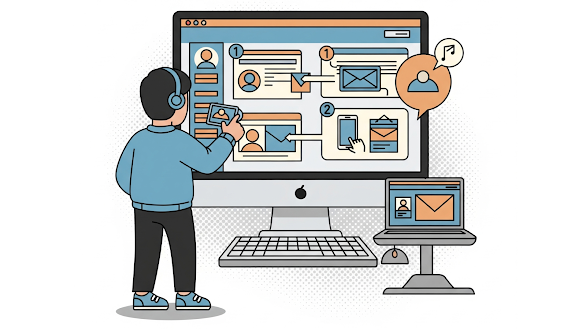In mid-2025, the world of technology tutorials is more dynamic and essential than ever. As AI permeates every facet of digital life and new hardware innovations emerge at lightning speed, the demand for clear, concise, and accessible learning resources has exploded. The current landscape of tech tutorials reflects not just the latest innovations but also a significant shift in how people learn and interact with technology.
1. The Domination of AI-Driven Tutorial Platforms
The most significant trend is the rise of AI-powered tutorial platforms that offer personalized learning paths. These platforms use machine learning to assess a user's current knowledge, learning style, and goals, then dynamically generate or curate content (text, video, interactive exercises) to maximize comprehension. Some even integrate AI chatbots that act as virtual tutors, answering questions in real-time and providing contextual explanations.
Analysis: This trend is driven by the sheer volume and complexity of new technologies. Traditional, one-size-fits-all tutorials often fail to cater to diverse learning needs. AI platforms address this by making learning more efficient and engaging. For instance, someone in Bekasi Regency wanting to learn about a new AI model can get a tutorial tailored to their existing coding knowledge, rather than sifting through generic guides. This personalization enhances retention and speeds up skill acquisition. The challenge, however, lies in ensuring the accuracy and unbiased nature of AI-generated content, as well as the privacy of user learning data. There's also the ongoing debate about the balance between AI assistance and fostering independent problem-solving skills.
2. Micro-Learning and Short-Form Video Content Reigns Supreme
The attention economy has profoundly impacted how tutorials are consumed. Short-form video platforms (like TikTok, YouTube Shorts, and Instagram Reels, along with dedicated educational micro-learning apps) have become primary sources for quick, digestible tech tutorials. These "snackable" lessons, often under two minutes, focus on solving a single, specific problem or explaining a core concept.
Analysis: This trend reflects a shift towards immediate gratification and "just-in-time" learning. Users often seek solutions to specific problems (e.g., "how to use a new AI feature in Photoshop," "setting up a smart home device") rather than comprehensive courses. The visual nature and rapid pacing of short videos make complex topics more approachable, especially for visual learners. This is particularly effective for practical skills where a quick demonstration is more impactful than lengthy text. However, the limitation is depth; complex topics often require multiple micro-lessons or supplementary resources. The challenge for creators is to distill information effectively without sacrificing accuracy or essential context.
3. "Hands-On" Interactive Tutorials and Simulation Environments
There's a strong push towards interactive tutorials that allow users to practice skills in simulated environments without needing to set up complex local development tools. Platforms offering in-browser coding environments, virtual labs for cybersecurity, or simulated interfaces for new software applications are gaining immense popularity.
Analysis: The "learning by doing" approach has always been effective, and technology is now enabling this at scale. Interactive tutorials reduce the friction of getting started with new tech, lowering the barrier to entry for beginners. Instead of just watching a video on coding, a user can write and execute code directly within the tutorial itself. This immediate feedback loop significantly enhances skill development and confidence. This trend is particularly relevant for complex technical fields like programming, data science, and cloud computing, where practical application is key to understanding. The main hurdle is the development cost and technical complexity of building these sophisticated simulation environments.
4. Tutorials for AI Integration and Prompt Engineering
With AI tools becoming ubiquitous, a massive new category of tutorials has emerged: AI integration and prompt engineering. Users are actively seeking guides on how to effectively use tools like ChatGPT, Midjourney, Stable Diffusion, and other specialized AI applications in their workflows. This includes tutorials on crafting effective prompts, fine-tuning models, and integrating AI into existing software ecosystems.
Analysis: This trend highlights a fundamental shift in digital literacy. It's no longer just about understanding software interfaces, but about communicating effectively with AI. Prompt engineering, in particular, has become a sought-after skill, as the quality of AI output directly depends on the quality of the input. These tutorials are crucial for individuals and businesses looking to leverage AI for productivity, creativity, and problem-solving. This shift is democratizing access to powerful AI capabilities, allowing non-developers to harness these tools. The challenge for tutorial creators is keeping pace with the rapid evolution of AI models and techniques, as best practices for prompt engineering can change frequently.
5. Accessibility and Multilingual Support Are Prioritized
As technology's reach expands globally, there's a growing emphasis on making tutorials accessible and multilingual. Platforms are investing in robust translation services, AI-powered dubbing and subtitling, and features catering to users with disabilities (e.g., screen reader compatibility, alternative text descriptions).
Analysis: This trend reflects a commitment to digital inclusion and a recognition of the global nature of tech adoption. For users in Indonesia, for instance, high-quality tech tutorials available in Bahasa Indonesia are invaluable for bridging the language barrier and fostering local tech talent. By making tutorials accessible to a wider audience, platforms are not only expanding their user base but also fostering a more diverse and inclusive tech community. The challenges include maintaining translation accuracy for technical terms and ensuring that accessibility features truly meet the diverse needs of all learners.
Conclusion: Empowering the Digital Age
The current trends in technology tutorials underscore a fundamental evolution in how we learn and adapt to the relentless pace of technological change. From personalized AI-driven platforms to bite-sized video lessons and immersive interactive environments, the focus is on making complex technologies understandable and actionable for everyone. As AI continues its rapid ascent and new innovations redefine our digital landscape, high-quality, accessible, and adaptive tech tutorials will remain critical tools for empowering individuals and driving progress in the mid-2025 digital age.



Social Media